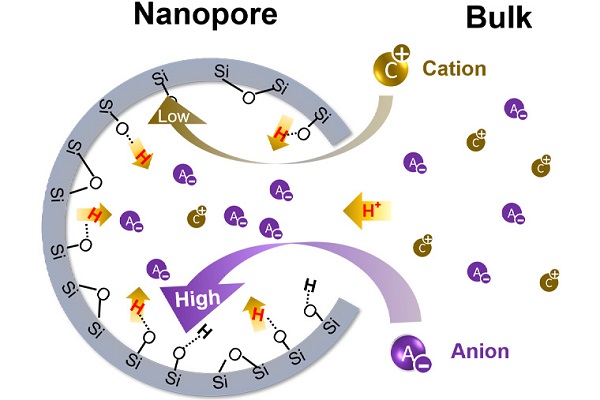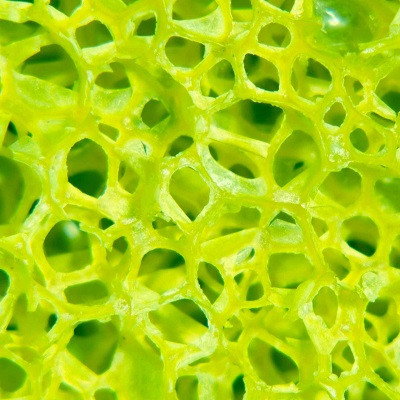There is an entire aqueous universe hidden within the tiny pores of many natural and engineered materials. Research from the McKelvey School of Engineering at Washington University in St. Louis has shown that when such materials are submerged in liquid, the chemistry inside the tiny pores — known as nanopores — can differ critically from that in the bulk solution.
In fact, in higher-salinity solutions, the pH inside of nanopores can be as much as 100 times more acidic than in the bulk solution.
The research findings were published Aug. 22 in the journal CHEM.
A better understanding of nanopores can have important consequences for a variety of engineering processes. Think, for example, of clean-water generation using membrane processes; decarbonization technologies for energy systems, including carbon capture and sequestration; hydrogen production and storage; and batteries.

In the lab, the research teams found that anions were preferred to transport in nanopores, inducing lower pH inside the nanopores than in the bulk solution. The higher the salinity of the solution, the greater the difference -- as much as 100 times more acidic.
Young-Shin Jun, a professor of energy, environmental and chemical engineering, and Srikanth Singamaneni, the Lilyan & E. Lisle Hughes Professor in the Department of Mechanical Engineering & Materials Science, wanted to understand how pH — the measure of how acidic or basic a liquid is —in nanopores differed from that of the bulk liquid solution they are submerged in.
“pH is a ‘master variable’ for water chemistry,” Jun said. “When it is measured in practice, people are really measuring the pH of the bulk solution, not the pH inside the material’s nanopores.
“And if they are different, that is a big deal because the information about the little tiny space will change the entire prediction in the system.”
Jun and her former PhD student Yaguang Zhu worked with Singamaneni and his former PhD student Hamed Gholami Derami. Singamaneni had developed plasmonic nanoparticle sensors that reported how pH changed as it moved through a biological system. The sensors consist of a gold nanoparticle paired with a molecule that is sensitive to pH — exactly the kind of sensor Jun could use.
When light is shined on the pH probe molecules, the pH of their immediate environment is reported by small changes in their Raman scattering. However, normal Raman scattering offers an extremely weak signal, making it hard to detect. That effect is magnified by the gold nanoparticle, which acts as a sort of antenna, amplifying the Raman scattering effect.
In order to measure the pH in nanopores, Singamaneni encased a nanosensor in a silica shell with pores just three nanometers in diameter and put it into liquid solutions with different chemistries. The team verified that the sensors only provided chemical information from inside the silica nanopores, including the pH, and were not contaminated by the bulk solution.
And because the gold nanoparticles amplify Raman scattering of molecules only in their immediate vicinity, they can also provide information about molecules and ions inside the pores.
“It doesn’t matter how the pH outside the nanopore is changing,” Singamaneni said, “because the probe molecule is not sensing that. It is only sensing what is happening in the local environment.”
In the lab, the research teams found that anions (negatively charged ions) preferentially transported into nanopores, inducing lower pH inside the nanopores than in the bulk solution.
The higher the salinity of the solution, the greater the difference (as much as 100 times more acidic!). In the real world, this could be relevant for brines from desalination plants, oil and gas recovery, or geologic carbon sequestration. Many engineered materials also harness unique nanopore spaces for gaining higher reactivity in processes.
This finding may help explain long-standing mysteries in engineering processes where the results tend to disagree with predicted outcomes.
“This gives us predictive power,” Jun said. “Previously, we’d been utilizing just information from the bulk systems. We thought the chemistries involved in the bulk solution and the solution in nanopores were the same, but we found the nanopores create a unique aqueous universe that can host important reactions that cannot happen in bulk solution.”
This work is supported by American Chemical Society’s Petroleum Research Fund (62756-ND5) and the Air Force Office of Scientific Research (FA95501910394).
Read the original article on Washington University in St. Louis.
